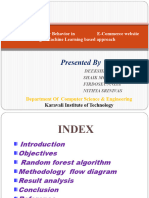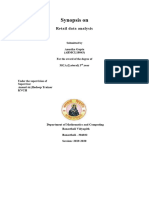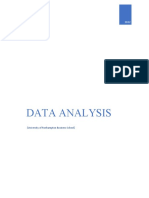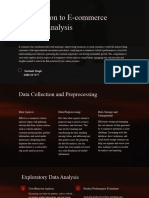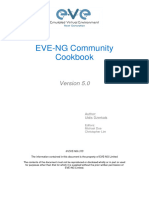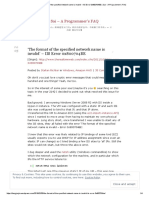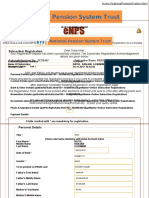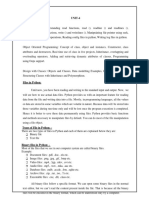PROJECT ANALYSIS OF SHOPPING TRENDS
USING DATA ANALYTICS
A Synopsis Submitted
In Partial Fulfillment of the Requirements for the Degree of
Bachelor of Technology
By
HARJIT SINGH BHADAURIYA CS-2341816
KESHAV KUMAR CS-23411078
Under the Supervision of
Mr. Shantanu Bindewari
Submitted to
Department of Computer Science and Engineering
2024-2025
� Project Title : Project Analysis of
Shopping Trends Using Data
Analytics
1. Objective and Scope of the Project
Objective: The primary objective of this project is to conduct a
comprehensive analysis of consumer shopping behaviors. The aim is to
gain actionable insights from various data points such as customer
demographics, purchase preferences, payment methods, and seasonal
trends. This data-driven analysis will assist businesses in making informed
decisions to enhance customer satisfaction, streamline inventory
management, and improve marketing strategies.
Scope: The scope of this project encompasses a wide range of activities and
outcomes, including but not limited to:
1. Consumer Behavior Analysis: Identifying patterns in consumer spending,
preferred product categories, and purchasing frequency.
2. Trend Identification: Analyzing the influence of discounts, promotions,
and seasonal events such as Black Friday or holiday sales on shopping
behavior.
3. Payment Preferences: Understanding the adoption trends of digital
payment methods like credit cards, digital wallets, and Buy Now Pay Later
(BNPL) services.
4. Predictive Insights: Utilizing machine learning models to predict
customer preferences and forecast future purchasing trends.
5. Sentiment Analysis: Applying text analytics to customer reviews to
understand their satisfaction levels and identify areas of improvement.
6. Customer Retention Strategies: Recommending strategies based on
insights gathered to foster customer loyalty and enhance engagement.
7. Visualization and Reporting: Presenting the findings through dashboards
and visual reports to assist stakeholders in decision-making.
�2. Literature Review (Comparison of Existing and Proposed
System)
Existing System: Relies on surveys and manual studies, which are time-
consuming, limited, and lack real-time insights.
Proposed System: Utilizes data analytics and machine learning for large-scale,
real-time analysis, providing predictive insights and personalized
recommendations.
3. Methodology
1. Data Collection: Gathering 3,900 shopping records, including customer
demographics, product details, payment methods, and purchasing
frequency. Additional data may be collected via APIs and web scraping.
2. Data Preprocessing: Cleaning the data by handling missing values,
normalizing data, and encoding categorical features to ensure consistency
and accuracy.
3. Exploratory Data Analysis (EDA): Using visualization tools like
histograms and heatmaps to identify trends, correlations, and patterns in
the data.
4. Predictive Modeling: Applying machine learning models such as decision
trees, random forests, and neural networks to predict customer
preferences and behaviors.
5. Results Interpretation: Deriving actionable insights to assist businesses
in decision-making, including personalized marketing and inventory
management strategies.
6. Visualization: Creating dashboards using tools like Tableau for clear
representation of trends and insights.
7. Performance Evaluation: Validating models through accuracy, precision,
recall, and cross-validation techniques to ensure robust results.
4. Hardware & Software to be used
• Hardware: Standard computing devices like laptops/desktops with
sufficient processing power for data processing tasks. Cloud computing
resources such as Google Cloud or AWS for handling large datasets.
• Software:
o Programming Tools: Python with libraries like Pandas, NumPy,
Matplotlib, Seaborn, and Scikit-learn.
o Data Storage: SQL for structured data storage and querying.
o Machine Learning Frameworks: TensorFlow for advanced machine
� learning models.
o Visualization: Tableau for creating interactive dashboards.
o Development Environment: Jupyter Notebook for coding and
model experimentation.
5. Testing Technologies to be used
1. Data Validation: Ensuring data accuracy and completeness.
2. Model Performance Evaluation: Using metrics like accuracy, precision,
and F1-score.
3. Cross-validation: Applying k-fold validation to enhance model
generalization.
4. A/B Testing: Comparing model versions for optimal performance.
5. Stress Testing: Ensuring system scalability under heavy loads.
6. Integration Testing: Validating seamless operation of components.
7. User Acceptance Testing: Ensuring the system meets user requirements.
6. Conclusion
The analysis of shopping trends provides crucial insights into consumer
behavior, enabling businesses to refine their marketing strategies, optimize
inventory management, and enhance customer engagement. Data-driven
decision-making fosters personalized shopping experiences and drives
profitability. By leveraging predictive analytics and machine learning, businesses
can better understand consumer preferences, adapt to market changes, and
maintain a competitive edge.
7. References
1. Academic papers and research on consumer behavior analytics.
2. Python library documentation (Pandas, Scikit-learn, TensorFlow).
3. Reports on e-commerce and retail trends.
4. Case studies from companies like Amazon and Walmart.
5. Books and journals on data analytics in retail.
6. Ethical guidelines for data collection and consumer privacy.
7. Industry best practices for machine learning implementation.

















